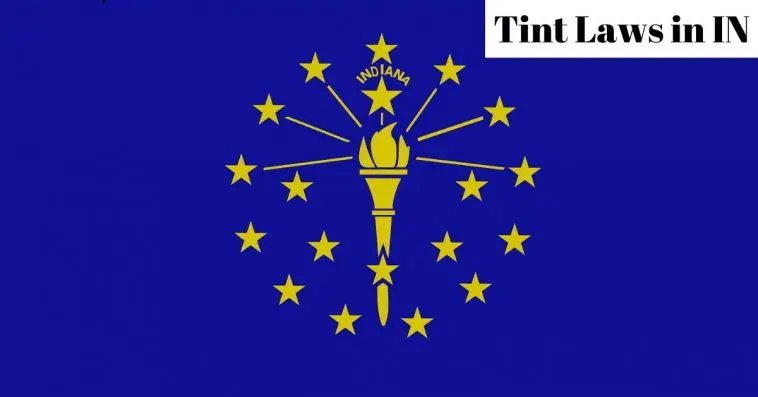Drivers have many reasons for wanting to tint their car. These reasons can be geographical- for example, Floridians have to tint their windows because the sun is so intense.
Meanwhile, a person living in a neighborhood known for car theft can help prevent their vehicle from getting stolen by utilizing tints. Others might just like the look of tints.
I know there are many drivers in Indiana interested in tinting their windows for a variety of reasons.
That is the purpose of this article- to show you laws and regulations surrounding window tinting so you can enjoy a safe, comfortable and lawful drive.
TABLE OF CONTENTS
Are You Allowed To Have Tinted Windshield And Windows n Indiana?
The answer is yes, you are allowed to have tinted windows as a driver in Indiana.
But for windshields, the answer is that you can only have a non-reflective tint above the AS-1 line.
There’s more to it than that. Let’s begin by defining VLT or Visible Light Transmission. This refers to the amount of light that can come through your auto’s windows. This is measured by a percentage, and your tints must meet this percentage to be legal.
In Indiana, this percentage is 30%. It also makes a difference whether you are driving a passenger vehicle or MPV, too.
What Is The Darkest Tint You Can Legally Get In IN?
30% tint is the limit for most automobile windows. There are some exceptions:
- Only non-reflective tint can be used on windshields above the AS-1 Line.
- Back side windows and rear windows can use any level of darkness so long as it is applied several inches (no specific number is given) from the top of the window.
Is 20 Tint Illegal In IN?
Yes. Since 30% tint is the legal limit allowed in Indiana, you cannot have 20% tint.
Can You Get Pulled Over For Tinted Windows In Indiana?
Yes. In 2013, the State Supreme Court voted 5-0 to allow police officers to stop vehicles equipped with tinted windows if that officer suspects the tints are too dark, whether or not that tinting is compliant with state law.
The tint statute is prohibitive of driving a vehicle that has side, rear, or front windows tinted to the point where one cannot see the occupants while standing outside of the vehicle.
That being said, the statute also states the violation will be dismissed if you are able to show that the VLT percentage is at least 30%.
How Much Is A Tint Ticket In IN?
The fines will vary from county to county. In Howard County, for example, a window tint fine appears to cost $159.
Meanwhile, in Marion County, it seems that if drivers admit their violation and fix the problem, they are fined $75. However, this ticket doubles if they fail to correct their tints and answer the charge.
Tickets may also be fought in court, but drivers could be looking at a $500 fine if they don’t win.
With so many variations and factors going into how much you could be paying if stopped, it’s better to stick with the legal limit of 30% to avoid run-ins with the police or courts.
Window Tint Darkness In Indiana
You already know about the basics of window tints in Indiana, but let’s get into specifics.
As mentioned, it makes a difference whether you are driving a MPV (multi-purpose vehicle) or a passenger vehicle.
Passenger vehicles are your standard, everyday family cars: sedans, convertibles, coupes, station wagons, and hatchbacks. These cars lack cargo space, cargo beds and third-row seating.
On the other hand, MPVs include SUVs, utility/panel vans, crossovers, pickup trucks, and RVs. If you can carry over five people, or the vehicle is built for work or utility purposes or contains a built-in living space, you have an MPV.
If you’re unsure about what you have, simply check the driver’s door frame for the Federal ID. It will tell you what kind of car you own.
For Passenger Vehicle
- Windshield: Non-Reflective tint is permitted above the AS-1 line
- Front Side Windows: Must allow greater than 30% of light to enter
- Back Side Windows: Must allow greater than 30% of light to enter
- Rear Window: Must allow greater than 30% of light to enter
For MPV (Multi Purpose Vehicle)
- Windshield: Non-reflective tint is permitted above the AS-1 Line
- Front Side Windows: Must allow greater than 30% of light to enter
- Back Side Windows: Must allow greater than 30% of light to enter
- Rear Window: Any darkness may be used so long as it is placed several inches (no specific length listed) from the window’s top
Window Tint Reflection In Indiana
Reflective tint is great for the reduction of glare and incoming light. It helps reduce heat, too.
Some reflection is permitted in the state of Indiana, so do make sure you stay within the legal limits if choosing reflective tints.
For Passenger Vehicle
- Front Side Window: Must not exceed 25% reflection
- Back Side Window: Must not exceed 25% reflection
For MPV (Multi Purpose Vehicle)
- Front Side Window: Must not exceed 25% reflection
- Back Side Window: Must not exceed 25% reflection
How Do You Get A Medical Exemption For Window Tint In Indiana?
Medical exemptions are permitted for tints in Indiana. An optometrist or physician licensed for practice in the state of Indiana must certify your need for tints darker than the state VLT limit, and you must carry that certification in your vehicle.
You must also renew your optometrist’s or physician’s certification each year.
Conclusion
I hope this article has been helpful to you as you figure out whether or not tints are for you.
They certainly make a big difference when it comes to keeping your car comfortable and cool, especially if you are a Georgian living near the Florida border where things get REALLY warm.
The best thing to do is have your tints applied at a professional dealer so you can stay safe and within the parameters of the law, and avoid getting stuck with fines or fees due to tints that are too dark.




